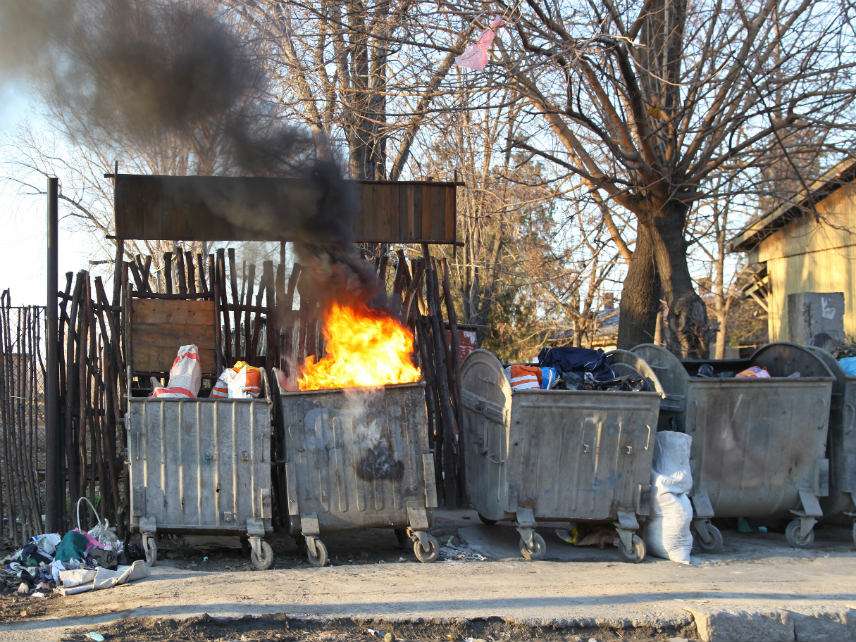Maryland's New 'Clean Energy' Bill Includes Millions in Subsidies for Pollution-Spewing Trash Incinerators and Paper Mills
The state treats burning trash as a renewable energy source worthy of taxpayer support.

Environmentalists in Maryland are split over a newly passed state bill that jacks up the percentage of the state's electricity that must come from renewable sources while also directing millions of dollars in subsidies to pollution-spewing trash incinerators.
On Monday, the Maryland General Assembly passed the Clean Energy Jobs Act, which mandates that 50 percent of the state's power come from renewable sources by 2030, with 14.5 percent of that coming from solar energy. That is a hefty increase from the state's current goal of 25 percent renewable energy by 2020, of which only 2.5 percent had to be solar.
The bump in the renewable mandate may look like a real win for environmentalists and renewable energy companies, and, indeed, many are treating it as such.
"The global warming crisis is here, and the Clean Energy Jobs [Act] is our answer," said Brooke Harper of the Chesapeake Climate Action Network in a press release, describing the passage of the bill as "a historic vote that creates jobs, fights climate change, and makes a difference."
"With the passage of the Clean Energy Jobs Act of 2019, Maryland is reclaiming its leadership position in the fast-developing offshore wind energy sector underway in the United States," said Salvo Vitale, of Baltimore-based wind energy company U.S. Wind, in a statement.
As with a lot of legislation, however, the devil is in the details. So what actually counts as renewable energy? In the case of the Clean Energy Jobs Act of 2019, that category includes the decidedly less-than-green practice of burning things like municipal solid waste and black liquor—a waste byproduct sourced from paper mills.
"Trash incineration is the most expensive and polluting way to make energy or to manage waste. It's actually worse than putting waste directly into landfills, and is dirtier than coal-fired plants," says Mike Ewall of the Energy Justice Network. "Subsidizing them makes no sense."
Three trash incineration plants currently provide Maryland with electricity. There is one in Baltimore; another in Montgomery County near Washington, D.C.; and a third across the state border in Fairfax County, Virginia.
Maryland sources its black liquor-generated power from 11 paper mills located in a number of different states.
The Baltimore trash incinerator, The Wheelabrator, is the city's largest source of industrial pollution. A report by the Chesapeake Bay Foundation, a nonprofit, found that the plant caused $55 million in health problems a year.
Nevertheless, the plant has collected about $10 million over six years in subsidies, according to a 2017 Baltimore Sun article, thanks to its status under state law as a renewable energy source. Black liquor producers have received another $60 million in subsidies from the state.
Since 2004, Maryland has set goals for the amounts of energy that the state's utilities had to source from qualified renewable sources. The state also provided subsidies in the form of refundable tax credits to the producers of these qualified renewable sources.
In 2011, the state legislature broadened the list of what it considered "renewable" to include those dirty trash incinerators, allowing their proprietors to collect clean energy tax credits, and securing them ready customers from utilities looking to meet their renewable energy mandates.
In 2017, trash incinerators produced 10 percent of the "renewable energy" in Maryland, while black liquor accounted for 24 percent.
Past efforts to cut black liquor off from clean energy subsidies have run into concerted opposition from the United Steel Workers Union, which represents workers at most of the paper mills that Maryland sources electricity from.
An attempt to get trash incineration out of the state's clean energy program has come much closer to success. This year, the state Senate amended the Clean Jobs Act to exclude trash incineration as an acceptable renewable energy source. But that change nearly killed the bill, and the incinerators were added back in by the state's House of Delegates.
Trash incineration's continued inclusion in this year's Clean Energy Jobs bill—as well as in a state plan to study the feasibility of nuclear power—has Ewall and the Energy Justice Network asking Maryland's Republican governor, Larry Hogan, to veto the bill.
As to why other environmental groups are singing the bill's praises, Ewall says it's a matter of priorities.
"The difference is that you have some groups that just want to report back to their funders and say, 'look we have a 50 percent goal now instead of 25,'" says Ewall. "It's not important to them that the dirty stuff is out, but for us, from a public health perspective, and an environmental justice perspective, that is paramount."
At the very least, a state's clean energy initiative should focus on actual clean energy, not on funneling millions of dollars in subsidies to some of the state's worst polluters.
Rent Free is a weekly newsletter from Christian Britschgi on urbanism and the fight for less regulation, more housing, more property rights, and more freedom in America's cities.


Show Comments (45)